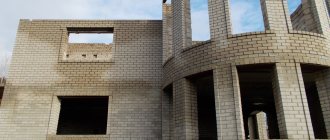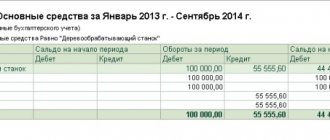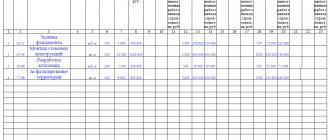Author: Ivan Ivanov
Unfinished construction are those costs incurred by the developer during the construction of real estate from the moment construction work begins until the moment it is delivered. They are accounted for in accounting account 08 “Investments in non-current assets”. Such costs should include financial expenses for installation and construction work, the purchase of tools and equipment, as well as other material objects of long-term use.
Basic concepts and analysis
In the process of compiling reports by the accounting department, the volume of unfinished construction is regarded as unfinished capital investments. Among them, in addition to the expenses listed above, it is customary to include objects that are in temporary use until their final commissioning into permanent operation. Such objects should also include real estate that has not gone through the state registration procedure.
In the balance sheet, unfinished capital-type investments must be reflected according to the amount of actual expenses on the part of the investor.
At the time of completion of construction work, the investor has completed construction in the amount of actual financial investments in the property that is put into operation.
Acceptance of completed construction projects onto the company's balance sheet must go through a registration procedure established by the organization's management. Financial investments in construction, as well as other types of expenses, must be written off from account 08 “Investing in non-current assets” to the account of used property assets or sources of their financing.
Any objects that are unfinished construction until they are put into operation can be sold, transferred through a gift, sent for conservation, and so on. The procedure for registering such transactions, as well as their reflection in accounting, is carried out within the framework of the procedure previously established at the enterprise.
Construction in progress is an asset or liability on the balance sheet
Form 1 “BALANCE SHEET”
Line 130 “Construction in progress”
Line 130 reflects:
[Debit balance on account 07 “Equipment for installation”]
[Debit balance of subaccount 08 “Investments in non-current assets (Construction of fixed assets)”]
[Debit balance on account 15 “Procurement and acquisition of material assets” (in the part related to equipment for the installation)]
[Debit balance on account 16 “Deviations in the cost of material assets” (in terms of deviations related to property, the cost of which is reflected in accounts 07 and 08)]
[Credit balance on subaccount 02 “Depreciation on real estate items recorded on account 08”]
“Construction in progress” is the amount of unfinished capital investments. These include expenses for construction and installation work, acquisition of buildings, equipment, vehicles, tools, inventory, and other material objects not formalized by acts of acceptance and transfer of fixed assets and other documents (including documents confirming state registration of real estate in cases established by law). durable use, other capital work and costs (design and survey, geological exploration and drilling work, costs of land acquisition and resettlement in connection with construction, training of personnel for newly constructed organizations, and others).
Account 07 “Equipment for installation” is intended to summarize information on the availability and movement of technological, energy and production equipment (including equipment for workshops, pilot plants and laboratories) that require installation and are intended for installation in facilities under construction (reconstruction). This account is used by property developers.
Equipment that requires installation also includes equipment that is put into operation only after its parts have been assembled and attached to the foundation or supports, to the floor, interfloor ceilings and other load-bearing structures of buildings and structures, as well as sets of spare parts for such equipment. This equipment includes control and measuring equipment or other devices intended for installation as part of the installed equipment.
construction contract is a document establishing the obligations of the parties involved in its conclusion and implementation for new construction, reconstruction, expansion, technical re-equipment, repair of existing enterprises, buildings and structures, as well as the production of certain types and complexes of contract work that are construction objects.
construction project - a separate building or structure, type or complex of works, for the construction of which a separate project and estimate must be drawn up;
developer - investor, as well as other legal entities and individuals authorized by the investor to implement investment projects for capital construction;
investor - a legal entity or individual who invests their own, borrowed and raised funds in the creation and reproduction of fixed assets;
construction in progress - the developer’s costs for the construction of construction projects from the beginning of construction until the objects are put into operation;
completed construction - the developer’s costs for a commissioned construction project;
inventory cost of the object - the developer’s costs for the construction of the object in accordance with the construction contract from its beginning to commissioning;
contractor - a legal entity performing contract work for the developer under a construction contract;
contract work - work performed by a contractor, which includes construction, installation work, repair work on buildings and structures, as well as other types of work in accordance with the construction contract;
work in progress - the contractor’s costs at construction sites for unfinished work performed in accordance with the construction contract.
The object of accounting under a construction contract for the developer and contractor is the costs of the construction project incurred when performing certain types of work on objects built under one project or construction contract.
In accordance with the construction contract, payments between the developer and the contractor can be carried out:
| · | in the form of advances (interim payments) for work performed by the contractor on structural elements or stages; |
The developer's costs for the construction of an object consist of expenses associated with its construction (construction work, purchase of equipment, equipment installation work, other capital costs, costs that do not increase the cost of fixed assets), commissioning or delivery to the investor.
When the developer carries out contract work on his own, the accounting records reflect the actual costs incurred in connection with their implementation, including the costs of maintaining departments involved in organizing construction.
The contractor's costs consist of all actual expenses incurred related to the contract work performed by him in accordance with the construction contract, i.e. using material and labor resources, fixed assets and intangible assets, as well as other types of resources during the construction process.
The developer's financial result for activities related to construction is formed as the difference between the amount (limit) of funds for its maintenance included in the estimates for objects under construction in a given reporting period, and the actual costs of its maintenance.
The contractor can use two methods for determining the financial result, depending on the accepted forms of determining income.
Income can be determined by individual work performed and by construction project.
The contractor can use two methods for determining the financial result, depending on the accepted forms of determining income.
Income can be determined by individual work performed and by construction project.
Disclosure of information in financial statements
The organization’s financial statements disclose the following information on contracts executed during the reporting period:
The organization's financial statements disclose the following information for each contract not completed at the reporting date:
| · | the total amount of expenses incurred and profits recognized (less recognized losses) at the reporting date; |
| · | the amount of received advance payment, advances, deposits as of the reporting date; |
| · | the amount for work performed that is not presented to the customer until certain conditions are met or until identified deficiencies in the work are eliminated at the reporting date. |
The difference between the amount of accrued revenue not presented for payment, which is recognized in the income statement for previous and/or current reporting periods, and the amount of accrued revenue on interim accounts presented for payment is reflected in detail in the organization’s balance sheet:
Source
Application of the new MODU
Until the completion of construction work, expenses for the construction of real estate, which are included in the “Capital Investments” account, form unfinished construction.
In accounting, all costs for the construction of real estate must be grouped by technological construction, which is determined by estimate documents.
It is important to carry out the accounting process within the framework of the following structural structure:
- for construction work;
- for work related to the installation of equipment;
- for the purchase of equipment that is already being installed;
- for the purchase of equipment that does not require installation, or for the purchase of tools;
- for other types of capital expenditures;
- for financial expenses, which are not reflected in the increase in the value of fixed assets.
The accounting procedure for such types of work directly depends on the method of their production, which can take a contract or business form.
The contract production method assumes that completed and completed construction work, as well as equipment installation work, must be displayed on the developer’s “Capital Investment” account at a previously agreed price based on paid or already accepted invoices from contracting structures.
If it is established that the cost of construction or installation has been overstated based on invoices already paid or accepted for payment, the customer undertakes to reduce them by the amount of this overstatement and receive appropriate compensation, at the expense of amounts purchased by contractors, applied financial sources, or by reducing the amount of debt according to accepted to pay the invoice from the contractor for the list of works he has completed.
When using an economic methodology for performing such work, the cost accounting process should be carried out by the developer also within the framework of the “Capital Investment” account. It is carried out on the basis of the procedure established by the Typical Methodological Councils for Planning, as well as accounting for the cost of construction operations. At the same time, the actual costs of the developer must be reflected in the “Capital Investments” account.
Act on suspension of construction
Based on the results of the commission’s work, a corresponding document is drawn up, which is called an act of suspension of construction (form No. KS-17). The document is the main legal confirmation that work will be suspended and the facility itself will be mothballed. It must include the following information:
- name of the object, all its passport data;
- purpose of building construction;
- start date and expected completion date of work (as originally envisaged);
- the full cost of all work, which was initially agreed upon when the parties entered into the contract (estimated cost);
- the estimated cost of work that was actually completed before the date of termination in connection with the decision on conservation;
- the amount needed for conservation and maintenance work until construction resumes.
The act of suspension of construction has an approved, unified form and looks as shown in the screenshot.
Thus, in a legal sense, conservation is not a cessation of work, but its suspension caused by one reason or another. It is provided that the work will be resumed after a certain or indefinite period by the current developer or another company with which a new contract will be concluded.
Implementation and accounting process
In order to carry out the procedure for the sale or transfer of an unfinished real estate object, a commercial structure must register the ownership of this object as real estate, which is regulated by Articles 130 and 131 of the Civil Code of the Russian Federation, as well as Article 4 No. 122-FZ.
Such registration is permitted only if the contract between the customer and the contractor has already been terminated. This is regulated by paragraph 16 of the recommendations to the Letter drawn up by the Presidium of the Supreme Arbitration Court of the Russian Federation on February 16, 2001 No. 59. In the event that no operations have been carried out to register property rights in relation to the immovable object, then any financial manipulation with its participation will be illegal.
All proceeds received as a result of the sale of unfinished construction of real estate must be taken into account along with other income of the commercial organization at the time of transfer of ownership rights to the direct buyer. In relation to small businesses, except for issuers of publicly placed securities, a special procedure for accounting for their income and expenses is provided.
The process of revenue recognition should be reflected in the credits of account 91 “Other types of income and expenses.” At the same time, the price of an unfinished construction project will be recognized as other expenses and written off as a debit to account 91 “Other types of income and expenses.”
Legal understanding of the object
Regardless of what stage of construction a building is at, the construction of which is not completed, it refers to real estate, since the Civil Code of Russia (Article 130) directly states: everything that has an integral physical connection with the land refers to real estate.
However, in domestic legislation there is neither the very concept of such an object nor its precise definition. In practice, an understanding of this term has developed that simultaneously corresponds to all of the listed characteristics:
- this is an immovable object, the construction of which is at any stage: from the construction of the foundation and first floor to work related to the installation of windows, doors, communication structures in a completed house;
- the building is a so-called capital (long-term) construction object: i.e. kiosks, stalls and other temporary structures do not meet the definition;
- The construction process of such a building is suspended for various reasons until a specific date (or without specifying a date in case of objective impossibility) due to subjective factors: lack of funds, force majeure, changes in market conditions.
https://www.youtube.com/watch?v=QPUVIBIE0gQ
However, the Town Planning Code and other regulations do not directly indicate what can be considered a capital construction project. Therefore, at the theoretical level, difficulties in definition still exist.
The regulatory framework, which contains some grounds for interpreting the concept of an unfinished construction project, is as follows:
- Civil Code.
- Town Planning Code.
- Instructions on the procedure for preparing reports on capital construction.
Based on these documents, we can give the following definition: this is an immovable construction project that is not completed from a technical point of view: i.e. the construction of the building and/or installation of life support systems has not been completed in whole or in part, which excludes the possibility of living in it, organizing non-residential premises and any other type of operation.
Calculation of revenue
All income that was received as a result of the sale of unfinished construction of real estate must be taken into account as part of the income received from the sale in the process of determining the tax base for taxes paid under the simplified taxation system.
This also applies to those taxpayers who combine the use of a simplified taxation scheme in the format of taxes on imputed income for certain types of commercial activities.
Account correspondence
Unfinished construction of real estate assets is displayed at the time of the reporting calendar date in section 1 of the assets of the balance sheet as part of a complex item, which consists of residual funds in such accounts as 07 “Equipment to be installed”, 08 “Investments in non-current assets”, 60 “Payment for the services of contractors and the supply of materials to suppliers”, subaccount “Payment for issued advance accruals” - in the area of the balance of the advance payment transferred to both contractors and suppliers as payment for expenses directly related to construction work.
The process of accounting for financial costs for unfinished construction is carried out by developers who act as investors who are engaged in the construction of buildings for personal needs. In addition, accounting can also be kept by developers who act as customers, subject to the clauses of the agreement drawn up with investors to obtain the rights to ensure the organization of the process of construction of real estate.
If the construction process is carried out using the economic method, then the actual capital costs (purchase of building materials, payment of construction workers, operation and maintenance of special construction installations, mechanisms and vehicles) must be taken into account in account 08 “Investments in non-current assets”, as well as on the subaccount “Construction of fixed assets”.
The procedure for accounting for financial expenses for unfinished construction of real estate is carried out by the developer, who at the same time acts as an investor. This accounting is kept completely separate from the accounting of a commercial organization in the area of its main activity. All economic transactions related to the write-off of various costs are reflected in the debit of account 08.3 “Construction of fixed assets”.
Accounting for construction in progress in the accounting of an enterprise helps to minimize financial costs by understanding the level of financial investments in the construction of real estate and various activities associated with this process.
The procedure for accounting for unfinished construction projects
Expenses for unfinished objects in accounting are shown as cumulative totals. The cost of constructed facilities includes:
- amounts spent on installation and construction work;
- the price of purchasing equipment for installation in a building under construction;
- costs for the development of built-up areas;
- rent payments for land;
- payment for services for preparation of design and survey documentation;
- costs directly related to construction activities for a specific task.
IMPORTANT! Assets under construction cannot be depreciated.
When receiving primary documentation, the accountant summarizes all cost items for the constructed building or structure. In general, expenses are reflected in the cost of inventory, raw materials, finishing materials, wages for workers, and fuel for equipment. If a defect is discovered during an inspection of an object, it is included in the costs.
Question: Should an organization pay property tax if it has an unfinished building on its balance sheet that is being rented out, but permission to put it into operation has not yet been received? View answer
Before putting the facility into operation, its readiness is checked. Based on its results, an Act is drawn up. The document is signed and verified with the customer. After recognizing a structure as a tangible asset in accounting, the management of the enterprise can dispose of it in the following ways:
- sell to a third party;
- make a gratuitous transfer in favor of an individual or other institution;
- initiate mothballing of an asset if it will not be used for a long time (due to seasonality of production or a forced reduction in production volumes);
- transfer for temporary use under a lease agreement.
NOTE! When deciding on the method of using the constructed objects, it is necessary to coordinate the operation with the members of the commission created at the enterprise.
The procedure for transferring an object from the category of unfinished construction to completed involves signing an Asset Acceptance and Transfer Certificate and reflecting its value in accounting. The forms of acts are given in the Goskomstat decree of November 11, 1999, No. 110. The next step is to stop recording business transactions for this facility at the stage of construction in progress. All amounts accumulated in the account are transferred to the cost of the new fixed asset put into operation.
Procedure for freezing unfinished construction
Temporary suspension of the construction of a building or structure must be documented. The decision on the need for this operation is made by the customer; it is recorded in an order indicating the timing of the inventory. At the next stage, the developer is notified of the upcoming conservation of the property.
Before freezing construction at the site, an inventory is carried out. For this procedure, a commission body is created from representatives of the customer and the contractor. After inspecting the unfinished structure, members of the commission draw up an inventory list. The document reflects:
- name of the property;
- list of structural elements;
- construction stage.
After the inventory activities, a Temporary Stop of Construction Act is signed.
Are unfinished construction projects subject to corporate property tax ?
Sale of an unfinished asset
Only an object whose construction has been suspended can be sold. Before completing a transaction, it is necessary to register ownership of the structure being constructed. To do this, a set of title documentation for the land plot and a previously issued permit to begin construction work are submitted to Rosreestr (Article 40 of the Law of July 13, 2015 No. 218-FZ). The registration authority will need additional information:
- type of property asset being built;
- percentage of completion of the structure;
- purpose of the building according to the project.
In accounting, completed work is accepted into the balance sheet, and the contract agreement is terminated.








